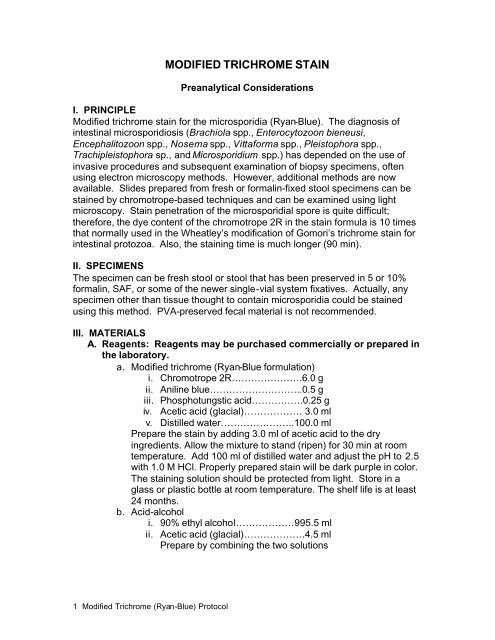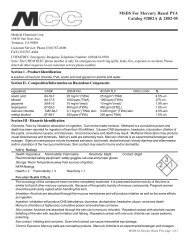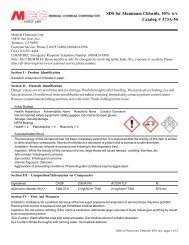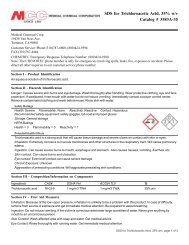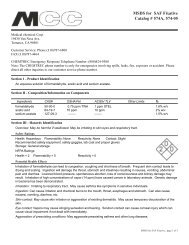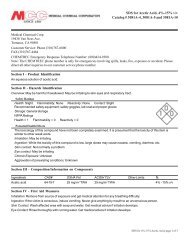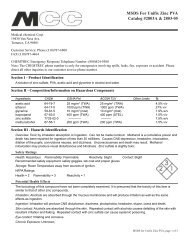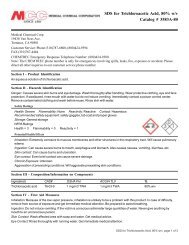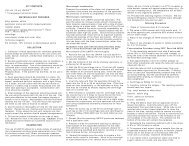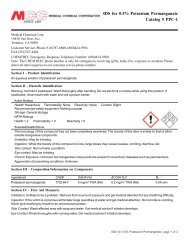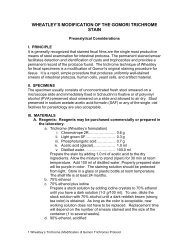MODIFIED TRICHROME STAIN
Modified Trichrome Stain (Ryan Blue) - Medical Chemical Corporation
Modified Trichrome Stain (Ryan Blue) - Medical Chemical Corporation
- No tags were found...
You also want an ePaper? Increase the reach of your titles
YUMPU automatically turns print PDFs into web optimized ePapers that Google loves.
<strong>MODIFIED</strong> <strong>TRICHROME</strong> <strong>STAIN</strong><br />
Preanalytical Considerations<br />
I. PRINCIPLE<br />
Modified trichrome stain for the microsporidia (Ryan-Blue). The diagnosis of<br />
intestinal microsporidiosis (Brachiola spp., Enterocytozoon bieneusi,<br />
Encephalitozoon spp., Nosema spp., Vittaforma spp., Pleistophora spp.,<br />
Trachipleistophora sp., and Microsporidium spp.) has depended on the use of<br />
invasive procedures and subsequent examination of biopsy specimens, often<br />
using electron microscopy methods. However, additional methods are now<br />
available. Slides prepared from fresh or formalin-fixed stool specimens can be<br />
stained by chromotrope-based techniques and can be examined using light<br />
microscopy. Stain penetration of the microsporidial spore is quite difficult;<br />
therefore, the dye content of the chromotrope 2R in the stain formula is 10 times<br />
that normally used in the Wheatley’s modification of Gomori’s trichrome stain for<br />
intestinal protozoa. Also, the staining time is much longer (90 min).<br />
II. SPECIMENS<br />
The specimen can be fresh stool or stool that has been preserved in 5 or 10%<br />
formalin, SAF, or some of the newer single-vial system fixatives. Actually, any<br />
specimen other than tissue thought to contain microsporidia could be stained<br />
using this method. PVA-preserved fecal material is not recommended.<br />
III. MATERIALS<br />
A. Reagents: Reagents may be purchased commercially or prepared in<br />
the laboratory.<br />
a. Modified trichrome (Ryan-Blue formulation)<br />
i. Chromotrope 2R………………….6.0 g<br />
ii. Aniline blue………………………..0.5 g<br />
iii. Phosphotungstic acid…………….0.25 g<br />
iv. Acetic acid (glacial)……………… 3.0 ml<br />
v. Distilled water…………………..100.0 ml<br />
Prepare the stain by adding 3.0 ml of acetic acid to the dry<br />
ingredients. Allow the mixture to stand (ripen) for 30 min at room<br />
temperature. Add 100 ml of distilled water and adjust the pH to 2.5<br />
with 1.0 M HCl. Properly prepared stain will be dark purple in color.<br />
The staining solution should be protected from light. Store in a<br />
glass or plastic bottle at room temperature. The shelf life is at least<br />
24 months.<br />
b. Acid-alcohol<br />
i. 90% ethyl alcohol………………995.5 ml<br />
ii. Acetic acid (glacial)……………….4.5 ml<br />
Prepare by combining the two solutions<br />
1 Modified Trichrome (Ryan-Blue) Protocol
B. Supplies<br />
a. Glass slides (25 by 75 mm), frosted ends desirable<br />
b. Coverslips (22 by 22 mm; no. 1)<br />
c. Glass or plastic centrifuge tubes<br />
d. Pasteur pipettes<br />
e. Coplin jars or other suitable staining containers<br />
f. Immersion oil<br />
C. Equipment: Optional materials, depending on specimen source of<br />
laboratory protocol<br />
a. Binocular microscope with 10X, 40X, and 100X objectives (or the<br />
approximate magnifications for low power, high dry power, and oil<br />
immersion examination).<br />
b. Oculars should be 10X. Some workers prefer 5X; however, overall<br />
smaller magnification may make final organism identifications more<br />
difficult.<br />
c. Tabletop centrifuge<br />
Analytical Considerations<br />
IV. QUALITY CONTROL<br />
A. Unfortunately, the only way to perform acceptable QC procedures for<br />
this method is to use actual microsporidial spores as the control<br />
organisms. Obtaining these positive controls may be somewhat<br />
difficult. It is particularly important to use the actual organisms because<br />
the spores are difficult to stain and the size is very small (1 to 1.5 µm).<br />
B. A QC slide should be included with each run of stained slides,<br />
particularly if the staining setup is used infrequently.<br />
C. All staining dishes should be covered to prevent evaporation of<br />
reagents (screw-cap Coplin jars or glass lids).<br />
D. Depending on the volume of slides stained, staining solutions will have<br />
to be changed on an as-needed basis.<br />
E. When the smear is thoroughly fixed and the stain is performed<br />
correctly, the spores will be ovoid and refractile, with the spore wall<br />
being bright pinkish red. Occasionally, the polar tube can be seen<br />
either as a stripe or as a diagonal line across the spore. The majority of<br />
the bacteria and other debris will tend to stain blue. However, there will<br />
still be some bacteria and debris that will stain red.<br />
F. The specimen is also checked for adherence to the slide<br />
(macroscopically).<br />
G. The microscope should be calibrated, and the objectives and oculars<br />
used for the calibration procedure should be used for all<br />
measurements on the microscope. The calibration factors for all<br />
objectives should be posted on the microscope for easy access<br />
(multiplication factors can be pasted on the body of the microscope).<br />
Although recalibration every 12 months may not be necessary, this will<br />
2 Modified Trichrome (Ryan-Blue) Protocol
vary from laboratory to laboratory, depending on equipment care and<br />
use. Although there is not universal agreement, the microscope<br />
should probably be recalibrated once each year. This<br />
recommendation should be considered with heavy use or if the<br />
microscope has been bumped or moved multiple times. If the<br />
microscope does not receive heavy use, then recalibration is not<br />
recommended on a yearly basis.<br />
H. Known positive microscope slides, Kodachrome 2 x 2 projection<br />
slides, and photographs (reference books) should be available at the<br />
work station.<br />
I. Record all QC results; the laboratory should also have an action plan<br />
for ``out of control'' results.<br />
V. PROCEDURE<br />
A. Using a 10-µl aliquot of concentrated (formalin ethyl-acetate<br />
sedimentation concentration; 500 X g for 10 min centrifugation),<br />
preserved liquid stool (5 or 10% formalin or SAF), prepare the smear<br />
by spreading the material over an area of 45 by 25 mm.<br />
B. Allow the smear to air dry.<br />
C. Place the smear in absolute methanol for 5 or 10 min.<br />
D. Allow the smear to air dry.<br />
E. Place in trichrome stain for 90 min.<br />
F. Rinse in acid-alcohol for no more than 10 s (1 to 3 s).<br />
G. Briefly rinse; dip slides several times in 95% alcohol. Use this step as a<br />
rinse (no more than 10 s).<br />
H. Place in 95% alcohol for 5 min.*<br />
I. Place in 95% alcohol for 5 min.*<br />
J. Place in 100% alcohol for 10 min.*<br />
K. Place in xylene substitute for 10 min.<br />
L. Mount with coverslip (no. 1 thickness), using mounting medium (this<br />
step is optional).<br />
M. Examine smears under oil immersion (1,000 x) and read at least 100<br />
fields; the examination time will probably be at least 10 min per slide.<br />
* Another option would be:<br />
H. Place in 100% alcohol for 3 min.<br />
I. Place in 100% alcohol for 3 min.<br />
J. Move to step “K”<br />
VI. RESULTS<br />
A. Microsporidia spores might be seen. The spore wall should stain<br />
pinkish to red, with the interior of the spore being clear or perhaps<br />
showing a horizontal or diagonal stripe that represents the polar tube.<br />
The background will appear blue (Ryan Stain).<br />
B. Other bacteria, some yeast cells, and some debris will stain pink to<br />
red; the shapes and sizes of the various components may be helpful in<br />
differentiating the spores from other structures.<br />
3 Modified Trichrome (Ryan-Blue) Protocol
C. The results from this staining procedure should be reported only if the<br />
positive control smears are acceptable. The production of<br />
immunoassay reagents should provide a more specific and sensitive<br />
approach to the identification of the microsporidia in fecal specimens.<br />
Postanalytical Considerations<br />
VII. REPORTING RESULTS<br />
A. Report the organism and stage (do not use abbreviations<br />
Examples (Stool Specimens): Microsporidia spores present<br />
Enterocytozoon bieneusi or Encephalitozoon<br />
(Septata) intestinalis present (if from fecal<br />
specimen); the two organisms cannot be<br />
differentiated on the basis of size or<br />
morphology.<br />
Example from urine: Encephalitozoon (Septata) intestinalis present<br />
(identification to species highly likely);<br />
generally this organism is involved in<br />
disseminated cases from GI tract to kidneys<br />
and will be found in urine.<br />
B. Quantitate the number of spores seen (rare, few, moderate, many).<br />
VIII. PROCEDURE NOTES<br />
A. It is mandatory that positive control smears be stained and examined<br />
each time patient specimens are stained and examined.<br />
B. Because of the difficulty in getting stain penetration through the spore<br />
wall, prepare thin smears and do not reduce the staining time in<br />
trichrome. Also, make sure the slides are not left too long in the<br />
decolorizing agent (acid-alcohol). If the control organisms are too light,<br />
leave them in the trichrome longer and shorten the time to two dips in<br />
the acid-alcohol solution. Also, remember that the 95% alcohol rinse<br />
after the acid-alcohol should be performed quickly to prevent<br />
additional destaining from the acid alcohol reagent.<br />
C. In the final stages of dehydration, the 100% ethanol and the xylenes<br />
(or xylene substitutes) should be kept as free from water as possible.<br />
Coplin jars must have tight-fitting caps to prevent both evaporation of<br />
reagents and absorption of moisture. If the xylene becomes cloudy<br />
after addition of slides from 100% alcohol, return the slides to 100%<br />
alcohol and replace the xylene with fresh stock.<br />
IX. LIMITATIONS OF THE PROCEDURE<br />
A. Although this staining method will stain the microsporidia, the range of<br />
stain intensity and the small size of the spores will cause some<br />
difficulty in identifying these organisms. Since this procedure will result<br />
in many other organisms or objects staining in stool specimens,<br />
4 Modified Trichrome (Ryan-Blue) Protocol
differentiation of the microsporidia from surrounding material will still be<br />
very difficult. There also tends to be some slight size variation among<br />
the spores.<br />
B. If the patient has severe watery diarrhea, there will be less artifact<br />
material in the stool to confuse with the microsporidial spores;<br />
however, if the stool is semiformed or formed, the amount of artifact<br />
material will be much greater; thus, the spores will be much harder to<br />
detect and identify. Also, remember that the number of spores will vary<br />
according to the stool consistency (the more diarrhetic, the more<br />
spores that will be present).<br />
C. Those who developed some of these procedures feel that<br />
concentration procedures result in an actual loss of microsporidial<br />
spores; thus there is a strong recommendation to use unconcentrated,<br />
formalinized stool. However, there are no data indicating what<br />
centrifugation speeds, etc., were used in the study.<br />
D. In the UCLA Clinical Microbiology Laboratory, we have generated data<br />
(unpublished) to indicate that centrifugation at 500 X g for 10 min<br />
increases dramatically the number of microsporidial spores available<br />
for staining (from the concentrate sediment). This is the same protocol<br />
we use for centrifugation of all stool specimens, regardless of the<br />
suspected organism.<br />
E. Avoid the use of wet gauze filtration (an old, standardized method of<br />
filtering stool prior to centrifugation) with too many layers of gauze that<br />
may trap organisms and allow them to flow into the fluid to be<br />
concentrated. It is recommended that no more than two layers of<br />
gauze be used. Another option is to use the commercially available<br />
concentration systems that use metal or plastic screens for filtration.<br />
SUPPLEMENTAL READING<br />
1. Garcia, L.S. 2001. Diagnostic Medical Parasitology, ed 4., ASM<br />
Press, Washington, D.C.<br />
2. NCCLS. 1997. Procedures for the recovery and identification of<br />
parasites from the intestinal tract, Approved Guideline, M28-A,<br />
National Committee for Clinical Laboratory Standards,<br />
Villanova, PA.<br />
3. Ryan, N.J., G. Sutherland, K. Coughlan, M. Globan, J.<br />
Doultree, J.Marshall, R.W. Baird, J. Pedersen, and B. Dwyer.<br />
1993. A New Trichrome-Blue Stain for Detection of<br />
Microsporidial Species in Urine, Stool, and Nasopharyngeal<br />
Specimens. J. Clin. Microbiol. 31:3264–3269.<br />
5 Modified Trichrome (Ryan-Blue) Protocol
APPENDIX<br />
Trichrome-Blue stain reagents available from Medical Chemical Corporation are<br />
as follows:<br />
REAGENT<br />
CATALOG<br />
NUMBER<br />
SIZE AND CATALOG<br />
NUMBER<br />
Ryan modification of Trichrome-Blue 601A 601A 16 oz<br />
95% Reagent Alcohol 3719A 3719A 1 gal<br />
Reagent Alcohol<br />
90% ethyl alcohol<br />
5% methyl alcohol<br />
5% isopropyl alcohol<br />
374B 374B -16 oz 16 oz<br />
374B -1gal 1 gal<br />
Trichrome Decolorizer 3720A 3720A-32 oz 32 oz<br />
3720-A1 gal 1 gal<br />
Xylene 134B 134B -16 oz 16 oz<br />
134B -1 gal 1 gal<br />
Xylene Substitute (d-limonene) 930E 930E 1 gal<br />
6 Modified Trichrome (Ryan-Blue) Protocol


